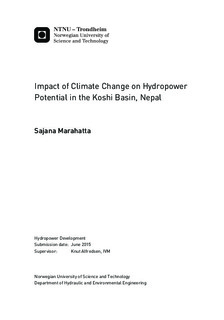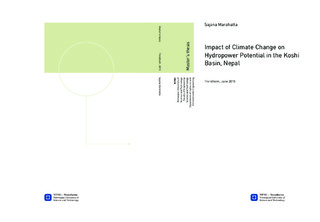| dc.description.abstract | Water resource has been termed as main source of development, in Nepal. Steep gradients, perennial river system and huge storage as snow in Himalayas makes perfect environment for hydropower production in Nepal. Such favourable environment may not remain same in future due to global climate change. In fact, Himalayas has been identified as the most vulnerable areas to climate change. So, continuous assessment of water resource availability now and in future, is a must to achieve sustainable development. This study aims to identify the possible impacts that climate change brings on hydrology and hydropower potential in Nepal with main focus on Koshi basin of Nepal. Climate change studies on Koshi basin has been done in past but the new thing about this study is that, it attempts to investigate the future projections under latest scenarios i.e. IPCC AR5 scenarios and focuses mainly on possible impacts on hydropower potential.
A good basin scale HBV model setup was done for Koshi basin with proper data quality analysis and selection of best representative stations for the basin. CORDEX data for South Asian domain were selected to make future projections. Analysis were based on two different models, shortly named as MPI and ICHEC and under scenarios RCP 2.6, 4.5 and 8.5 for mid and end century. Results suggested more seasonal impact rather than annual and were different with models used, especially in precipitation projections. MPI suggested usually a decreasing trend of precipitation while ICHEC suggested an increasing trend. Temperature is expected to increase with higher rate in winter and postmonsoon compared to monsoon while precipitation usually showed less rainfall in winter and premonsoon. The results were however different in water availability. Flow simulations under scenarios, showed an increasing trend throughout the year with very few exceptions, which could be a reason of snow melt due to increased temperature. This increased flow under scenarios simulated higher production results with an nMAG model set up made for a run-of-river hydroelectric system and also projected an increased flood spill in future. The extra flood spill could be utilized in upgrading the system in future with necessary planning and studies.
The results support in good hydropower potential in future if done under proper planning and utilization and to some extent, have overcome the fear of too little water available in future in annual basis. However, the seasonal changes are pronounced with higher possibility of warm and dry winters. Besides, the results are based on full basin scale analysis which may not be true on small scales thus sub basin scale analysis are highly recommended. Besides, the uncertainty in projections could not be neglected, thus different models and study approaches are required for future work. | |

